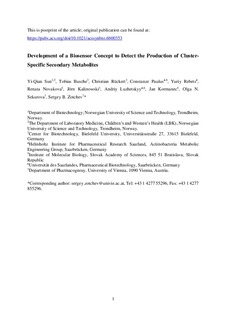| dc.contributor.author | Sun, Yi-Qian | |
| dc.contributor.author | Busche, Tobias | |
| dc.contributor.author | Rückert, Christian | |
| dc.contributor.author | Paulus, Constanze | |
| dc.contributor.author | Rebets, Yuriy | |
| dc.contributor.author | Novakova, Renata | |
| dc.contributor.author | Kalinowski, Jörn | |
| dc.contributor.author | Luzhetskyy, Andriy | |
| dc.contributor.author | Kormanec, Jan | |
| dc.contributor.author | Sekurova, Olga N. | |
| dc.contributor.author | Zotchev, Sergey B. | |
| dc.date.accessioned | 2018-08-27T11:56:06Z | |
| dc.date.available | 2018-08-27T11:56:06Z | |
| dc.date.created | 2017-06-28T08:46:34Z | |
| dc.date.issued | 2017 | |
| dc.identifier.citation | ACS Synthetic Biology. 2017, 6 (6), 1026-1033. | nb_NO |
| dc.identifier.issn | 2161-5063 | |
| dc.identifier.uri | http://hdl.handle.net/11250/2559429 | |
| dc.description.abstract | Genome mining of actinomycete bacteria aims at the discovery of novel bioactive secondary metabolites that can be developed into drugs. A new repressor-based biosensor to detect activated secondary metabolite biosynthesis gene clusters in Streptomyces was developed. Biosynthetic gene clusters for undecylprodigiosin and coelimycin in the genome of Streptomyces lividans TK24, which encoded TetR-like repressors and appeared to be almost "silent" based on the RNA-seq data, were chosen for the proof-of-principle studies. The bpsA reporter gene for indigoidine synthetase was placed under control of the promotor/operator regions presumed to be controlled by the cluster-associated TetR-like repressors. While the biosensor for undecylprodigiosin turned out to be nonfunctional, the coelimycin biosensor was shown to perform as expected, turning on biosynthesis of indigoidine in response to the concomitant production of coelimycin. The developed reporter system concept can be applied to those cryptic gene clusters that encode metabolite-sensing repressors to speed up discovery of novel bioactive compounds in Streptomyces. | nb_NO |
| dc.language.iso | eng | nb_NO |
| dc.publisher | American Chemical Society | nb_NO |
| dc.title | Development of a Biosensor Concept to Detect the Production of Cluster-Specific Secondary Metabolites | nb_NO |
| dc.type | Journal article | nb_NO |
| dc.type | Peer reviewed | nb_NO |
| dc.description.version | acceptedVersion | nb_NO |
| dc.source.pagenumber | 1026-1033 | nb_NO |
| dc.source.volume | 6 | nb_NO |
| dc.source.journal | ACS Synthetic Biology | nb_NO |
| dc.source.issue | 6 | nb_NO |
| dc.identifier.doi | 10.1021/acssynbio.6b00353 | |
| dc.identifier.cristin | 1479347 | |
| dc.description.localcode | This document is the Accepted Manuscript version of a Published Work that appeared in final form in [ACS Synthetic Biology], copyright © American Chemical Society after peer review and technical editing by the publisher. To access the final edited and published work see [insert ACS Articles on Request author-directed link to Published Work, see http://pubs.acs.org/page/policy/articlesonrequest/index.html]. | nb_NO |
| cristin.unitcode | 194,65,15,0 | |
| cristin.unitname | Institutt for klinisk og molekylær medisin | |
| cristin.ispublished | true | |
| cristin.fulltext | postprint | |
| cristin.qualitycode | 1 | |
